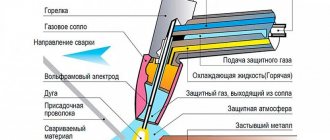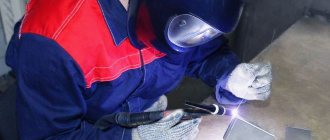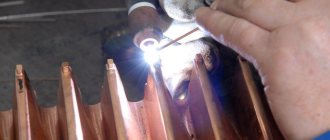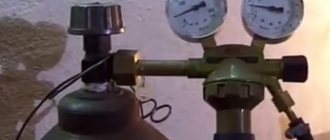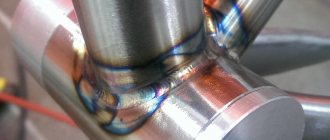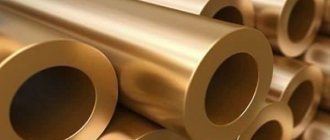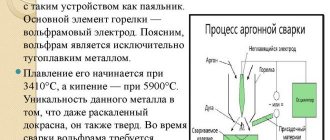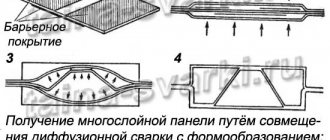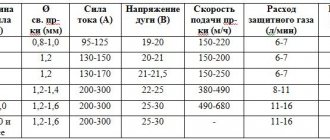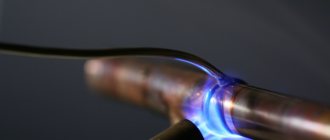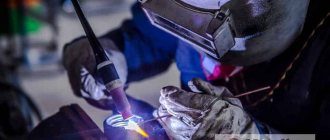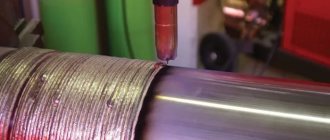To come in
Already registered? Sign in here.
There are currently 0 users on the page
There are no users viewing this page.
Connecting two different metals, which includes soldering stainless steel and copper, is always a rather complicated procedure. Taking into account the fact that stainless steel has rather complex thinning during heat treatment, and also interacts poorly with other metals, for a high-quality soldering result it is necessary to select a clearly verified technology. If, as a rule, there are no problems with copper, this often happens with stainless steel.
The process itself is regulated by GOST 17349-79, but there is one very important feature. After all, each metal has its own characteristics of joining during this process, so they require the use of different solder and flux, selected for their parameters. But when connecting different metals, it is necessary to take some average or highly specialized materials.
This type of soldering is used both at home and in industrial settings, to create sealed containers, solder copper pipes and other things. This process is not as common as other types of soldering, but if necessary, you should know all the features of this method.
Is it possible to solder stainless steel to copper?
Soldering copper to stainless steel, although it is a rather complicated process, is still possible. The fact is that the connection of stainless steel to stainless steel and copper to copper occurs much more often, since the final quality of the connection is much better. But in various situations, when you need to make such a connection, you have to compromise on quality. Especially for such cases, special solders are produced that allow you to make a reliable connection that meets operational requirements. While for other types of soldering the use of flux is not always necessary, here it is necessary to carry out a full range of procedures, including tinning, and also to use all additional materials.
Brass welding technology using argon, video
A common problem with processing non-ferrous metals (and their alloys) at high temperatures is that under such conditions they are easily deformed.
The specificity of welding brass (copper + zinc) also lies in the fact that, firstly, the element “Zn” included in its composition (30th position in the periodic table) begins to evaporate already when heated to +420 ºС. Secondly, this process is accompanied by the release of a toxic component - the oxide of this metal. The technology of welding brass using argon is the most promising technique, as it eliminates many difficulties and ensures high speed of operations. What it consists of, what are the features of this work is the topic of this article.
Advantages of argon welding:
- Obtaining seams with the correct geometry, their utmost cleanliness. Waste is immediately removed from the working area by a gas jet.
- Uniformity of structure and strength of the permanent connection.
- Argon brass welding technology is considered the most economical. First of all, due to the low cost of tungsten electrodes.
- High speed.
Required conditions for safe welding:
- Reliable forced exhaust. When argon welding brass, natural air circulation is clearly not enough.
- Mandatory use of protective equipment by employees.
Features of brass argon welding technology
The essence of the work is to form a single-layer seam. At the end of the operation, it is forged. Why is “repetition” unacceptable? During the welding process, slag deposits are intensively formed. If the seam is passed twice, then how can you then break through the “crust” that will appear after the first treatment of the welded area?
Welding brass with argon is not recommended if the thickness of the samples does not exceed 5 mm.
Pre-treatment of edges with a special flux. The resulting film sharply reduces the intensity of zinc evaporation. Recommended compositions: No. 1 – borax (100%), No. 2 – borax (20%) + boric acid (80%).
Use of special (multicomponent) brass wire when welding. It contains Al, Fe and a number of other elements of the periodic table.
Temperature conditions (ºС) of annealing: heating of edges before welding – 750 (±50), during annealing – 625 (±25). Temperature change rate (heating/cooling) – 100 ºС/hour.
Burner power. It is selected as for welding steel samples - approximately 120 l/h of combustible mixture per 1 mm of alloy.
Preparatory activities:
- Inspect the respirator to identify damage.
- Checking the hood for efficient operation.
- To remove the oxide film and degrease the work area, you will need a solution (10%) of nitric acid and a metal brush.
- Treatment of joints of welded samples. The edges are pressed together at an angle of 65 (±5) 0. It is clear that the gap should expand upward.
- Cleaning the surfaces to be welded until shiny and degreasing.
- Installing the electrode into the burner.
Welding technique
Since the work is carried out with a tungsten electrode (non-consumable), an inverter (TIG device) is used. The wire is inserted into the bath manually, and the role of the welding flux is played by argon with a small proportion of oxygen.
Filling of the “cut” (the junction of the beveled edges) is done with an “overlap”, separate rollers.
Depressions formed at the junction are eliminated by moving the electrode away from the working area and reducing the current. The length of the arc increases, and at some point it breaks.
There are many descriptions of creating permanent connections of brass parts. They indicate various techniques. For example, using consumable electrodes, special fluxes when welding electric/contact. The described argon welding technology is attractive because it is easy to implement at the household level, even in the absence of sufficient experience.
Source: https://ismith.ru/welding/texnologiya-svarki-latuni-s-ispolzovaniem-argona/
Advantages
- This method allows solving complex technological operations;
- This is one of the few ways to achieve such a connection;
- The procedure itself occurs quite quickly and does not require additional tools, since an ordinary burner is sufficient for this;
- Modern developments of solders provide relatively high compatibility of metals during soldering;
- The process is available for both home and industrial needs.
Flaws
- The quality of soldering is inferior to other methods in terms of reliability;
- Finding the right solder is difficult;
- The flux oxidizes quickly, so the action must be carried out without delaying the start of heat treatment;
- Often, low-melting solders are used, which makes the processing process more complex, since you need to carefully regulate the temperature and ensure that nothing spreads.
Methods
There are several ways to make a connection of this kind, and they no longer depend on what kind of solder is used for soldering stainless steel to copper, but on the processing tool. Thus, two main ones stand out: soldering with a soldering iron and a torch.
In the first case, when using a soldering iron, this tool is used for relatively small parts. It is more convenient for them to connect small things, since there is no risk of overcooking them with too much heat. At the same time, the soldering iron itself is inferior in power to the torch and cannot work with hard-melting materials. They are also inconvenient for processing large surfaces, since in this case the process will be too long and the flux may oxidize by then.
The torch is the more commonly used method. It can be used for soldering stainless steel with copper, brass and other solders. Here you can easily process large surfaces and make hermetic connections. The process itself is much faster than with a soldering iron, and it is also possible to heat the workpiece to the desired temperature. The speed of the procedures does not allow the flux to oxidize.
Read also: Do-it-yourself autostart for a generator circuit
Solder selection
The final result of the work depends on the correct selection of solder, since it ensures the filling of the joint, which must be completely covered with material that must be well grasped on the surface. One of the simplest options is to solder stainless steel with brass. After all, this is a very common solder, which is also used for soldering stainless steel to stainless steel. In some cases it can be used without flux.
It is inferior in its properties to others, but is more common and accessible, so it is mainly suitable for simple connections that do not bear a lot of responsibility.”
Stainless steel is also soldered with copper-phosphorus solder, which improves the quality of the connection with copper. This is a more expensive material, but is better suited for critical connections.
Tin-silver solder, such as Castolin 157, is an excellent soldering method, but the material cost is higher than others.
In the simplest cases, radio-technical solder can be used, but depending on the production technology, it is better to choose specialized consumables.
Technology of soldering stainless steel with copper
Soldering stainless steel with brass or other solders begins with surface preparation.
- The material must be cleaned of all excess and all deposits removed, free of grease and possible rust;
- Then prepare the flux, tinning the joints of the workpieces and the solder itself;
- After the flux has been applied to the joints, you should place the workpiece in the desired place and lay out the solder;
This process should not be delayed, since the flux tends to oxidize.”
- Then you should gradually heat everything with a burner until the solder begins to melt;
- You need to ensure that it spreads evenly over the joint surface;
- Allow to cool naturally.
Quality control
The quality of soldering is controlled according to GOST 19249-73. There are several basic professional methods which include:
- Radioscopic method;
- Radiation control;
- Technical inspection.
Safety precautions
When working with a burner, you should pay attention to the connection of the gas cylinder and its location, as it poses the greatest danger. You also need to carefully handle hot objects that may not have cooled down after soldering. You should not come into direct contact with the flux, but rather use protective gloves.
Soldering stainless steel is a rather labor-intensive procedure, but it will not cause any special problems if you know all the features of its implementation. With significantly less labor, it is possible to solder stainless steel alloys that contain no more than 25% chromium and nickel. Moreover, soldering stainless steel with such a chemical composition allows you to obtain reliable connections of products from dissimilar metals, excluding alloys with magnesium and aluminum.
Solder repaired bicycle frame
Soldering stainless steel, which contains a significant amount of nickel, can be difficult. This is due to the fact that in such alloys, when heated to a temperature of 500–700°, carbide compounds appear. The intensity of the formation of such connections depends on the duration of heating, so soldering should be performed as quickly as possible.
To minimize the risk of the formation of carbide compounds in the stainless steel structure during soldering, titanium is added to the alloy composition, and after the joint is formed, the product is subjected to heat treatment. You should be very careful when soldering cold-worked stainless steels, the surface of which may become cracked under the influence of heated solder. To avoid such consequences, it is necessary to eliminate the load on the parts being connected during the soldering process. In addition, it is possible to pre-anneal the products being joined.
Use a gas torch for annealing.
The choice of solder with which to solder stainless steel is influenced by both the chemical composition of the alloy and the process conditions. So, if this process is carried out at high ambient humidity, then silver alloys should be used, which contain a small amount of nickel. Soldering in an oven, as well as in a relatively dry atmosphere, is performed using chromium-nickel and silver-manganese solders.
The most common type of flux used when soldering stainless steel is borax, applied to the future joint in the form of a paste or powder. Melting borax on the surface of the parts being joined contributes to uniform and most accurate heating of the area of the future seam to the required temperature - 850°. Only after the required heating temperature has been reached, which can be determined by the color change of the future joint to light red, is solder introduced into the joint between the parts.
Read also: Programs for drawing electrical circuits according to GOST
The flux is applied in an even layer over the entire surface, which must first be cleaned.
After soldering is completed, flux residues are present at the joint, which are removed by washing with water or sandblasting. To perform this procedure, you cannot use nitric or hydrochloric acids, which, although they effectively clean the flux remaining on the surface of the parts, have a negative effect on both the base metal and the used solder.
How to weld brass, what technologies exist
From a metallurgical point of view, these are two different alloys, which have differences in both physical and chemical properties. Industrially, all brass alloys are divided into two types:
- Single-phase alloy - an alloy in which zinc is present in an amount not exceeding 35%. It is also called “alpha” alloy. In terms of physical properties, alpha is characterized by plasticity. Products can be deformed without preheating them.
- The two-phase alloy contains much more zinc. Its share can reach 60%. This alloy is called "alpha-beta" and has a strong structure. Products made from two-phase brass are distinguished by their durability. To change the shape, it is necessary to increase the temperature of the product or increase the external pressure.
Peculiarities
Brass can be welded, but this process is considered technologically complex. The components included in its composition in the form of zinc and copper differ in physical and chemical properties, therefore, they behave differently under the same conditions. Despite this, welding is, in principle, possible.
If you learn all the features of the behavior of metals, you can carry out welding using trivial methods, and at home. In its technology, the process is similar to copper welding.
There are several traditional obstacles that every welder faces when carrying out the welding process. The main problem is the large gap between the melting temperatures of the metals that make up the brass alloy.
If the melting point for copper is 1080°C degrees, then zinc melts at 420°C, and at 905°C degrees zinc begins to boil (at normal pressure).
As a result of the action of the electric arc, the zinc melts and boils. From the place where the seam is formed, it gradually evaporates and burns out. Zinc reacts with oxygen during the welding process. The resulting oxide in the form of a film covers the part. It forms precisely in the seam zone, but it is this film that prevents normal fusion.
In addition, pores and cracks quickly begin to appear in brass when heated. They are due to the fact that as the temperature rises, the process of hydrogen absorption begins. It forms bubbles in molten metal. As a result, the porous structure of the seam negatively affects its strength.
To summarize the presented theory, we can identify three main problems characteristic of welding brass:
- evaporation and burnout of metal (zinc);
- formation of pores and cracks;
- formation of zinc oxide (white film).
Preparation
The thermal conductivity of the copper-zinc alloy is much lower than that of the constituent elements, so there is no need to preheat the workpieces for welding. If the thickness of the material is impressive, then you can limit yourself to local heating.
The joints of the workpieces are processed in several ways, based on the thickness of the metal sheet. With a thickness of up to 1.5 mm, a flange is made along the edge. The height of the side should reach twice the thickness of the sheet.
When the workpiece thickness is from 1.5 mm to 6 mm, the surfaces are not processed, and when welding, a gap of 1-2 mm is provided between the edges. The use of shims requires increasing the gap to 3 mm. Edges of greater thickness are cut at an angle of 30-45°C degrees.
In order to carry out high-quality welding of any alloy, it is necessary to take into account the properties of each component element. Welding brass is similar to welding copper, but the presence of zinc makes some adjustments to the algorithm. It is customary to distinguish three methods of welding brass:
- arc welding;
- argon arc welding;
- gas (gas-flame) welding.
Arc welding
Electric arc welding is carried out using inverter machines operating in MMA mode. For this purpose, special electrodes are used. The welding method depends on their type. A distinction is made between welding with brass or carbon electrodes.
Welding with brass electrodes is carried out with direct current of direct polarity. The operation is characterized by a short arc at a current of 250 A; this parameter is given for electrodes with a diameter of 5 mm. With such indicators, the suture application speed reaches 30 cm per minute. After applying the seam, it is subjected to forging and heating to 600°C degrees.
Welding with carbon electrodes involves the use of graphite consumables (thickly coated electrodes).
They consist of brass wire, which contains elements such as manganese, iron, aluminum and silicon. To produce the coating, mixtures of liquid glass with dry impurities are used. The most popular include manganese ore, ferromanganese, chalk chips, aluminum and graphite.
When using carbon electrodes, an additive coated with special fluxes is used. Such welding is carried out with the above parameters, however, they are already suitable for electrodes with a cross section of 10 mm. There are a number of mandatory conditions necessary to obtain a strong seam when conducting electric arc welding:
- Workpieces with a thickness of 6 mm or more should be locally heated before applying a seam.
- Thin sheets are welded in one pass. When several layers are applied to the workpiece, cracks will begin to appear in the seam area.
- The thickness limit for one pass is 3 mm.
- An asbestos lining is placed below or on the inside of the seam. It is needed to prevent metal leakage.
Argon
Argon or argon arc welding is a type of arc welding that has certain features. Welding is carried out with a non-consumable tungsten electrode in a protective gas environment, the role of which is argon.
If TIG inverters were as common as MMA inverters, brass TIG welding would be the most popular joining method. Moreover, this particular welding method ensures high quality.
They resort to the argon-arc method when welding fairly massive workpieces. First, the surfaces are prepared. It comes down to cleaning the edges to a characteristic shine. Brass oxidizes quickly, so you often have to deal with the oxide layer. To do this, the edges are treated with nitric acid, after which the workpiece should be washed and dried.
When welding, you need to get a long arc. A continuous seam is excluded, since in the process of its application the metal may burn through. The seam is formed from individual rollers.
Welding brass is characterized by a gradual decrease in voltage. When using a tungsten non-consumable electrode, an additive is used. The best option for the additive material is bronze or phosphorus.
A special rod is made from these elements, which is inserted at one end into the seam formation area. But when carrying out argon welding, the use of consumable electrodes is also allowed. One way or another, the process is accompanied by a characteristic cracking sound that occurs when zinc evaporates.
How to do soldering at home
Problems such as joining stainless steel parts using soldering and soldering stainless steel to copper are often encountered at home. Products made of stainless steel have been actively used in everyday life for many years, therefore, when for some reason they become unusable, any home craftsman has a natural desire to repair them himself. It should be said right away that soldering stainless steel parts is not so difficult, the main thing is to strictly adhere to the technology, as well as stock up on the appropriate tools and consumables.
Master the soldering technique on simple connections, and then try working with more critical parts
Before you start soldering stainless steel, it is very advisable not only to study the theoretical material on this issue, but also to become more familiar with the rules for its implementation using training videos.
To solder stainless steel products, you will need the following tools and consumables:
- a soldering iron powered by electricity with a power of at least 100 W;
- special soldering acid, which will be used as a flux;
- file or sandpaper;
- solder, specially designed for joining steel parts, based on tin and lead;
- cable made of steel;
- metal tube.
Soldering materials and tools
When choosing a soldering iron for working with stainless steel, you should opt for a tool with a power of 100 W. Using a more powerful device to perform such work is simply not practical.
The process of soldering stainless steel parts is carried out according to the following algorithm.
- First of all, it is necessary to thoroughly clean the area of the future connection, for which sandpaper or a file is used.
- After preparing the surfaces of the parts to be joined, it is necessary to apply flux to them, which, as mentioned above, uses soldering acid. The main task of the flux is to ensure high-quality tinning of the parts to be joined.
- After the surfaces of the parts to be joined are treated with flux, it is necessary to tinning them, which consists of applying a thin layer of solder consisting of tin and lead to them. If tinning was not successful the first time, then it is necessary to repeat this procedure, preheating the parts to be joined.
- Even after heating the products and re-processing them with flux, tinning may not be successful - the solder will simply roll off the surface of the parts, rather than lie on them as a thin film. In this case, you need to use a brush with metal wires, which can be easily made from a tube and steel cable. Before using such a brush, it is also necessary to apply flux (soldering acid) to the surface of the parts and only then, heating the future joint with a soldering iron, clean it with a metal brush. This simple technique allows you to effectively clean the surface of a stainless steel from an oxide film, which, as a rule, is the main obstacle to high-quality tinning.
- Once a thin layer of tin has been applied to the products to be joined, you can begin to solder them. This procedure is performed using a soldering iron and solder, which is used to fill the joint between the parts.
Gas
Gas welding of brass is used in exceptional cases. Basically, it is carried out in the absence of electricity or when it is impossible to conduct electric arc welding. The formed seam is quite strong and of high quality, but this method is accompanied by intense evaporation of zinc. This process can only be hindered by an oxidizing flame. As a result of the reaction of the compound with oxygen, a film is formed on the surface, which prevents the gas from escaping.
In gas welding, combustible gas is burned in a special burner. Its role is played by acetylene, hydrogen, natural gas, gasoline or kerosene vapor. The most popular is a mixture of acetylene and oxygen, as it has a high calorific value. The power of the flame directly affects the quality of the seam, so before performing work it is necessary to adjust the welding parameters. Gas welding technology involves heating the filler material in a flame. The rod with the additive should always be in a high temperature zone, and the seam itself should be applied at maximum speed.
The wire, which plays the role of filler material, does not require the use of additional flux. Silicon brass wire is usually used and produces a tight and durable weld. Excess waste must be washed off with water. The seam is then forged, annealed and slowly cooled. When working on a vertical surface, you should remember the fluidity of the metal.
Solder Types
Stainless steel products can be soldered with both soft solders made on the basis of tin and lead, and hard types of filler material, which includes more refractory metals.
Soft solder, due to the fact that it is based on tin, is a low-melting material characterized by high ductility and fluidity in the molten state. What is especially important when soldering stainless steel products is that it has good deoxidizing ability.
Properties of soft solders
More reliable connections both in production and at home can be achieved by soldering using hard solders. The metals from which they are made melt at a higher temperature than tin, which makes it possible to obtain reliable and durable connections with their help. Very often, materials of this type are produced on the basis of technical silver, which can contain up to 30% in their composition.
Read also: How to make a welding inverter with your own hands
Main brands of silver solders
One of the popular types of hard solder is the HTS-528 material, which is successfully used for soldering not only stainless steel, but also copper, brass, bronze, nickel and other metals. Conveniently, it is produced in the form of a rod, the surface of which is already covered with a layer of flux. When working with such solder in a production environment or at home, you should keep in mind that its melting point is 760°.
HTS-528 solder is a rod coated with red flux. In addition to stainless steel, it is suitable for cast iron and non-ferrous metals
Welding brass
Welding of brass can be done using almost all known methods. The choice of welding technology depends on the amount of alloying components in the alloy, most often zinc. Analogies can be drawn with copper welding; the technology and welding methods in both cases are almost completely the same.
Welding work with brass is most often used for the production of equipment for the chemical and food industries. For these purposes, profile steel is usually used, the fastening of which is carried out using resistance welding.
Features of welding brass products
Based on the composition and physical properties, some features of brass welding should be highlighted:
- creation of zinc oxide film;
- boiling of zinc followed by evaporation;
- formation of a porous structure of the weld.
The zinc contained in the alloy is subject to increased oxidation. When overheated, this metal enters into a chemical reaction with oxygen, resulting in the formation of an oxide film at the site of the weld. A white coating significantly impedes the connection of the elements being welded. This problem especially often occurs when welding brass at home.
Boiling and evaporation of zinc occurs as a result of the large difference in the melting point of copper and zinc. Zinc melts at a temperature of 420C, and copper at 1080C, which also exceeds the boiling point of zinc. Due to similar physical properties, welding of brass products is accompanied by the evaporation of zinc in large quantities.
Its burnout significantly affects the quality of the connection and the performance characteristics of the future product. Therefore, high-quality welding must be carried out at an optimal temperature for the required heating of copper and preservation of zinc in the alloy.
Such welding operations may be accompanied by the absorption of free hydrogen. This chemical reaction leads to the formation of a porous weld structure. Due to the fact that hydrogen does not have time to evaporate from the heated metal, gas bubbles remain in the structure of the weld.
The formation of porosity significantly affects the quality of the connection, which often leads to the formation of cracks and loss of strength. Preventing this problem from occurring is a major concern when welding brass. Thus, a product with a porous seam structure becomes simply unsuitable for industrial use.
To solve the above problems, welding work is carried out at an optimal temperature, which allows you to create a strong connection without serious changes in the physical state of the zinc.
For the same purposes, excess oxygen supply can be used, which prevents the formation of pores. The resulting oxides are reduced using additives. Silicon is most often used for such purposes. It oxidizes and precipitates, from which cleaning the seam is not difficult.
Preparing for welding brass parts is similar to preparing copper. Only unlike it, brass products of small thickness do not need to be preheated. It is advisable to heat thick elements at the welding site. This manipulation significantly improves the quality of the seam and the strength of the future product.
It is very important to process the working edges when preparing for work. If the edge thickness of the sheets is less than 1.5 mm, it is recommended to carry out flanging. This will double the thickness of the brass sheet and increase the strength of the future seam.
If the sheets are thick enough, there is no need to make flanging, but you should maintain a gap between the elements of about 2 mm. Increasing the gap can be done by using a lining. For products of increased strength, the double-sided welding method can be used. If the seam thickness is sufficient, this method will significantly increase the strength of the joint.
Preparing brass for welding is a very important stage, since incorrect assessment of the sheet thickness, weld length and incorrect choice of gap can lead to deformation of the structure. This occurs due to increased metal stress. In this regard, it is better to entrust the connection of thick elements to experienced specialists who professionally work with brass.
Brass welding technology
The technology is practically independent of the choice of welding method. There are certain rules and requirements for such work. It is recommended to adhere to a high welding speed - at least 15 cm per minute. A lower speed increases the risk of formation of a porous structure and excessive evaporation of zinc.
Vertical welding is performed from bottom to top; if necessary, the joint is heated additionally. Under no circumstances should ceiling welding be performed, since brass melts easily and has increased fluidity properties.
The choice of brass welding technology depends on individual wishes, sheet thickness and the desired characteristics of the finished product.
The following welding methods are usually used:
- argon;
- electric arc;
- gas-flame.
Argon welding is by far the most effective way to weld brass products. It is usually used when connecting elements with a thickness of more than 5 mm.
Flux preparation
When soldering stainless steel, you should be very careful about choosing a ready-made flux or the recipe for making it yourself. The classic flux composition, which can be prepared at home, includes the following components:
- borax (70%);
- boric acid (20%);
- calcium fluoride (10%).
For soldering small-sized products, you can prepare a flux that will consist only of borax and boric acid mixed in equal proportions. Having mixed the components of the flux in dry form, it must be diluted with water and treated with the resulting solution at the site of the future connection.
Useful tips
To perform stainless steel soldering efficiently, you should use the recommendations of experienced specialists.
- The power of a soldering iron, which must effectively heat the metal being joined, is in the range of 60–100 W, but it is better to opt for a 100-watt device. To solder large parts, such as stainless steel pipes, you will need a gas torch rather than an electric soldering iron.
- When choosing an electric soldering iron, it is better to opt for models equipped with tips that do not burn.
- The most economical and universal type of solder, which makes it possible to obtain high-quality connections for stainless steel products, is tin-lead rods. If you are soldering dishes that will come into contact with food or liquids, it is better to use pure tin as solder, which does not contain harmful impurities.
- The room in which soldering work is carried out must be well ventilated.
- When performing soldering, be sure to use personal protective equipment so as not to harm your health.
Four ways to weld brass
Brass is an alloy based on zinc and copper. The percentage of these base metals in any given alloy may vary. For example, zinc can be from 20 to 60%. In addition, other elements can be added to the alloy in small quantities.
Features of welding work with copper alloys
Brass is often compared to bronze. After all, bronzes are also alloys in which copper is present, and the second main component can be aluminum, silicon, lead, beryllium, and so on.
The thermal conductivity of copper is 6 times greater than that of iron. And therefore, the technology for welding copper alloys has serious differences from the technology for welding steel and iron products
What else you should know about soldering stainless steel
In cases where special requirements are imposed on soldered joints of stainless steel products, special grades of solders can be used, which include materials based on nickel and phosphorus, as well as nickel, chromium and manganese. Solders of the second group are used, in particular, in cases where soldering is performed in a protective gas environment consisting of a mixture of argon and boron trifluoride. When performing soldering using this technology, pure copper can be used as solder, which wets the metal well and forms a reliable connection.
When using copper solder, the soldering area will differ from stainless steel in a characteristic yellow color
Nickel-based solders make it possible to obtain joints with high strength. However, such materials also have disadvantages, which include low ductility. That is why such filler material is not used to connect stainless steel structural elements that will be subject to shock and vibration loads during their operation. In addition, a soldered seam made of such a material is very critical to low temperatures. Soldering with nickel group solders, which melt at temperatures exceeding 1000°, can be performed in dry hydrogen, argon and vacuum.
Thus, soldering stainless steel products (large pipes operated under pressure, dishes, pieces of furniture or interior design) has its own nuances, which must be taken into account when choosing both soldering modes and consumables. There are many reference books, guided by which, you can optimally select all the necessary materials and obtain a high-quality, reliable and beautiful soldered connection.
Bronze
Bronzes are alloys of copper and aluminum. They are designated by two letters “Br”, the initial letters of the Russian names of alloying elements and a series of numbers indicating the content of these elements in%.
Thus, the BrAZhMts 10-3-1.5 grade means that bronze contains 10% aluminum, 3% iron, 1.5% manganese. Some grades of cast bronze have the letter “L” at the end.
Approximate welding modes for bronze Br.AMts 9-2, Br.AZhMts 9-5-2 and brass LMNZH 55-3-1 in argon in the lower position (direct current, reverse polarity, wire Br. AMts 9-2)
| Type of connection | Size, mm | Welding process | Welding current, A | Arc voltage, V | Welding speed m/h | Electrode diameter, mm | Electrode extension, mm | Gas consumption, l/min | |
| S | b | ||||||||
| 3 | 0+1 | IDS KZ | 150-190 160-190 | 23-26 22-25 | 20-25 20-25 | 1-1,5 1-1,5 | 10-16 10-16 | 8-10 9-11 | |
| 4-5 | 0+1,5 | IDS KZ | 140-220 160-220 | 23-26 22-26 | 20-22 20-22 | 1-1,5 1-1,5 | 10-16 10-16 | 10-12 10-12 | |
| 8-10 | 0+1,5 0+2 | PAGE PAGE | 300-400 375-450 | 29-33 31-36 | 25-32 30-35 | 2-4 2-4 | 20-35 20-35 | 12-16 14-16 | |
| 14-16 | 0+2 | STR | 400-650 | 33-38 | 20-25 | 2-5 | 20-40 | 16-20 | |
| 24-26 | 0+2 | STR | 400-800 | 33-42 | 18-30 | 2-5 | 20-40 | 16-20 | |
The difficulty of welding bronzes is explained by their increased fluidity. When welding bronzes, difficulties arise due to the formation of aluminum oxide, so the welding method and technology are chosen the same as when welding aluminum, and the modes are characteristic of copper alloys.
